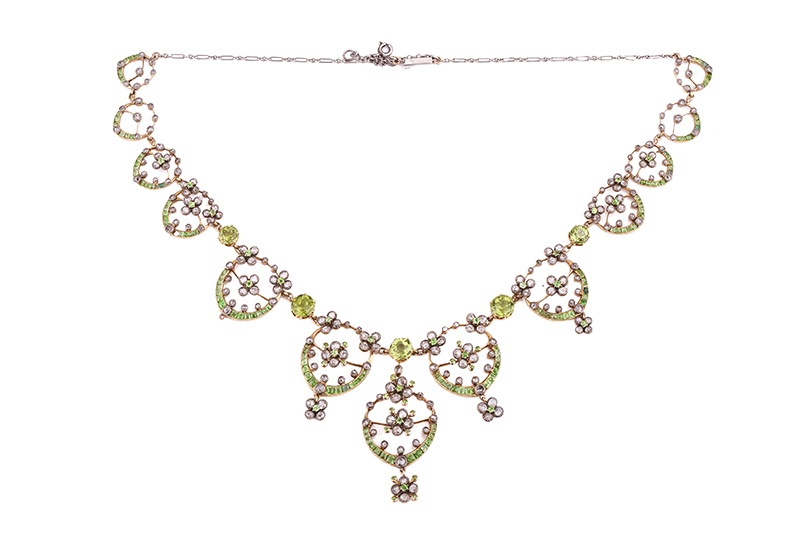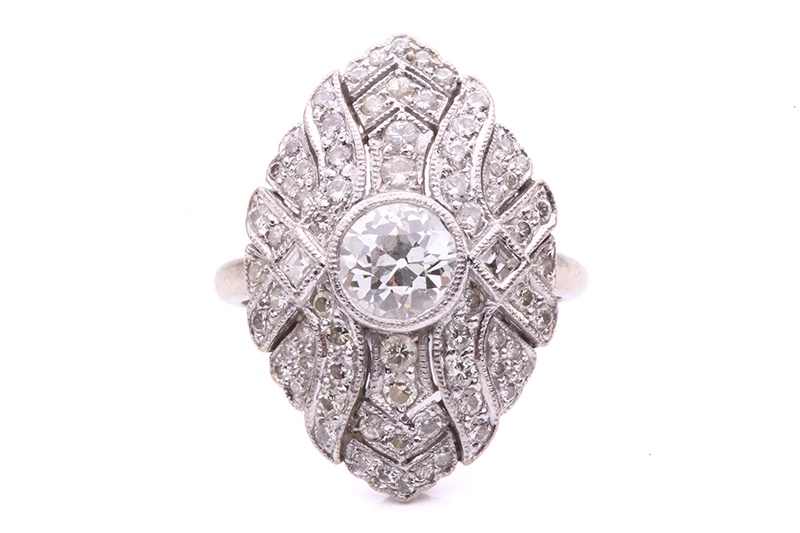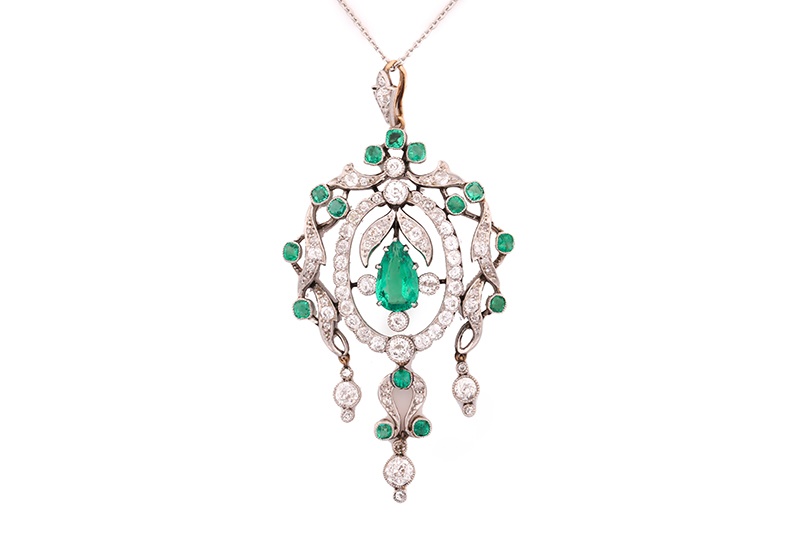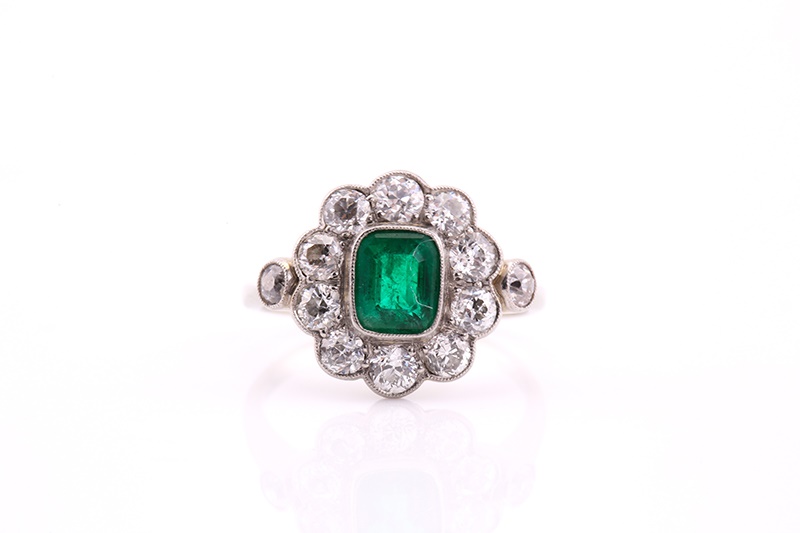How Can You Tell if Jewellery is Edwardian?
Surviving Edwardian jewellery is symbolic of an ostentatious and lavish era
15/01/2024
This was the last era of jewellery to derive its name from the reigning monarch. Eldest son of Queen Victoria and Prince Albert, King Edward VII (1901 – 1910) was the antithesis of his mother. Indeed, King Edward VII had a reputation for being a gambler and debonair playboy, and although his reign may have been brief, his love of luxury and everything expensive had a huge influence on this age of opulence.
An Edwardian emerald and diamond pendant
A Timeline:
Encompassed within “La Belle Époque” period (1890-1915), Edwardian jewels can include pieces made in the final decade of Queen Victoria’s reign and the years leading up to the First World War in 1914. Together with the Art Nouveau and Arts and Crafts movements, this period was a time of wealth and flourishing arts, hence being referred to as “The Beautiful Era".
 An Edwardian diamond, peridot and demantoid garnet necklace
An Edwardian diamond, peridot and demantoid garnet necklace
“Bertie”:
King Edward’s coronation was nothing short of a spectacular fashion parade, which was attended by royalty and aristocracy from all around the world. He commissioned twenty-seven tiaras from Cartier’s new London branch for the occasion, later appointing the firm a royal warrant. Edward famously referred to Cartier as “Jeweller of Kings and King of Jewellers”, thus cementing the role of the atelier firmly within the history of Edwardian jewellery. He spent most of his time engaged in social events, attending balls, parties, and soirées, mixing with frivolous wealthy upper class. Together with his wife, they helped to establish a high society where flagrant displays of material wealth were standard and fine elaborate jewellery was a prerequisite part of the dress code - “more is more”!
An Edwardian emerald and diamond cluster ring
The Bling:
Jewellery from the Edwardian era is delicate and well made by expert craftsmen looking for the opportunity to show off their skills. Drawing inspiration from 18th century style, jewellery became ethereal and detailed. Platinum rose to become the most favoured metal of the decade, its durability and strength allowed for intricate openwork designs such as filigree, as well as the refinement of millegrain settings. The “white on white” trend called for pale gemstones such as diamonds, pearls, aquamarines, peridots, amethysts, moonstones, and opals, but on occasion, emeralds, sapphires, rubies, and garnets were also used. Newly developed synthetic rubies and sapphires appear in late Edwardian jewellery. Coincidently green, white, and violet, which translates to “give women votes”, were also the colours of the suffragette movement, protesting for equal rights for women at the time. Thanks to the discovery of diamonds in South Africa, quality stones became more widely available and led to extraordinary developments in stone cutting, resulting in the baguette, marquise, emerald, briolette and Asscher cuts all coming into existence. The Swiss cut diamond replaced small rose-cut diamonds towards the end of this period.
Fashionista:
In this age, necklines shifted and became more revealing, which required grandiose necklaces to make up for the reduction in brooches. Traditional motifs such as bows, circles, swags, garlands, wreaths, ribbons, and lace were used. Invisible settings where diamonds appeared to float on the skin, and lace-like filigree settings were popular. Long glittering earrings replaced the simple stud fashion, while sautoirs and negligees were in favour. Cartier created the lavalier, named after the French actress, Ève Lavallière, an elongated, double-pendant negligee necklace. King Edward’s wife, Alexandra of Denmark, birthed the French colliers de Chiens “dog collars” trend. Even before Queen Victoria’s passing, she wore this type of necklace to cover a scar on her neck. Multiple strands of pearls forming a choker or black velvet/moire ribbons embellished with buckles/brooches are examples of this style.
 An Edwardian diamond panel ring
An Edwardian diamond panel ring
Playtime is Over:
When WWI broke out in 1914, platinum became a strategic metal that was diverted for use in weapons, engine parts and explosives, temporarily forbidden for use in jewellery. As the war effort eclipsed the frivolous party scene, so the Edwardian era ended.
The Legacy:
Surviving Edwardian jewellery is symbolic of this ostentatious and lavish era. Pieces will be light, intricate, delicate, and detailed, the design and style will also offer clues to the origin. Metals used would likely be platinum, gold plated with platinum and gold, British hallmarks can provide the exact year of manufacture.
read more
Is Antique Jewellery Worth Anything?
Are Jewellery Valuations Free?

Nicky Houston
Our Head of Jewellery, Watches & Silver... Nicky is a highly respected Auctioneer & Valuer, who had dreams of becoming an artist. Whilst she may not have made it as a successful artist herself, Nicky has helped many a customer to successfully sell and buy beautiful pieces of jewellery and works of art over her many years working within the auction industry.
Jewellery Silver & Objects of Virtue Watches
Are you considering selling Edwardian or other antique jewellery?
With a global audience of over 10 million, Dawsons can achieve the best price for you at auction.
Please do get in touch for a complimentary valuation. Our Jewellery Specialists would be delighted to help:

